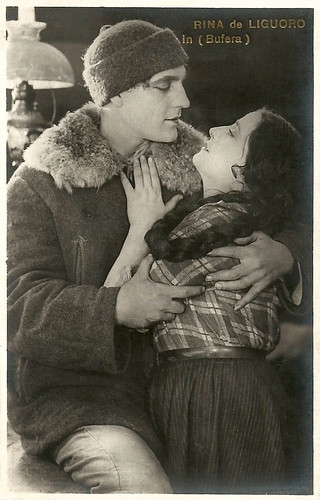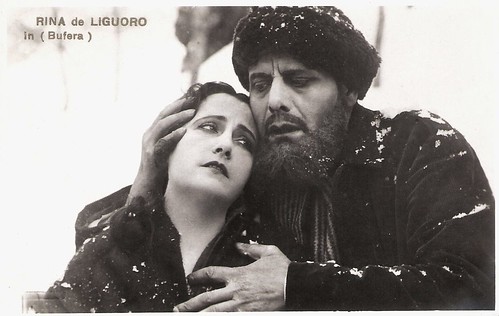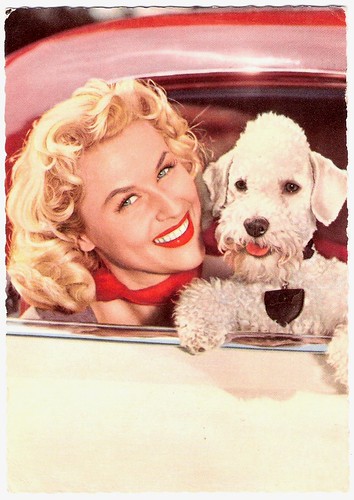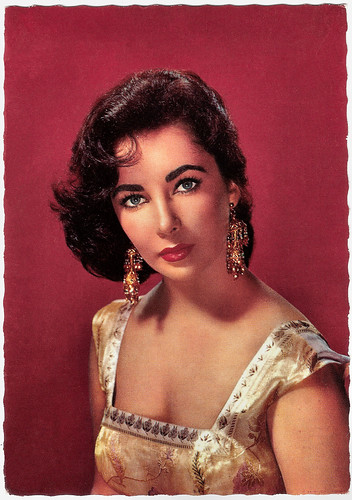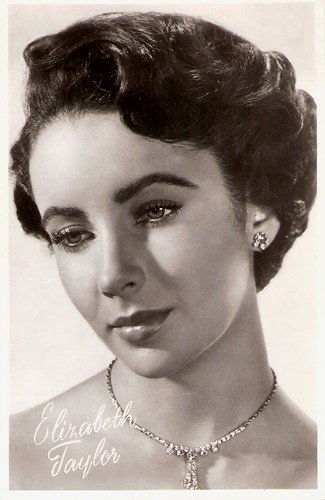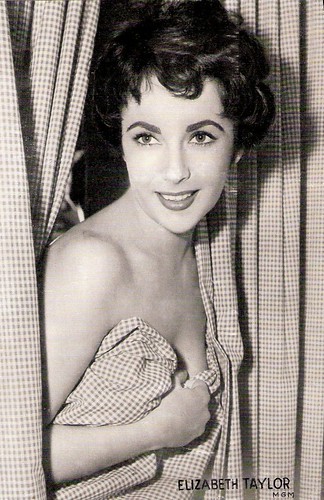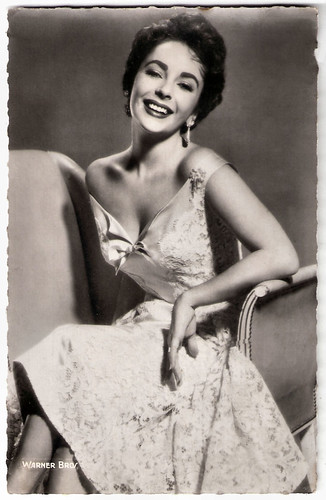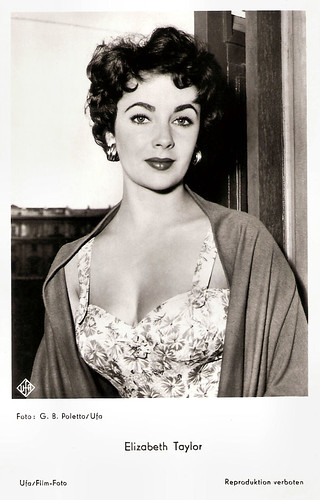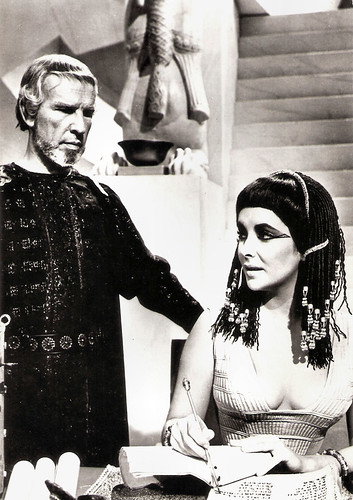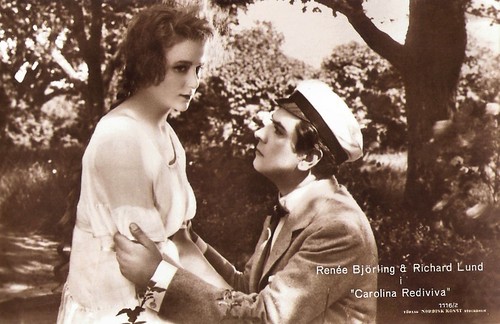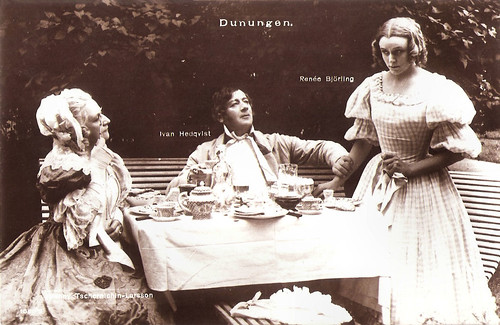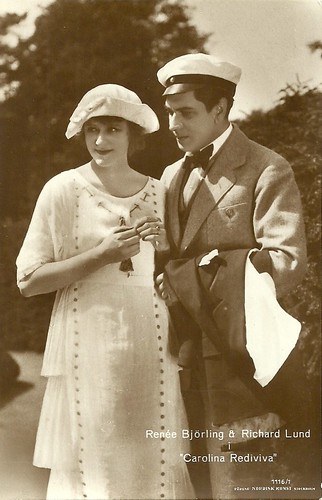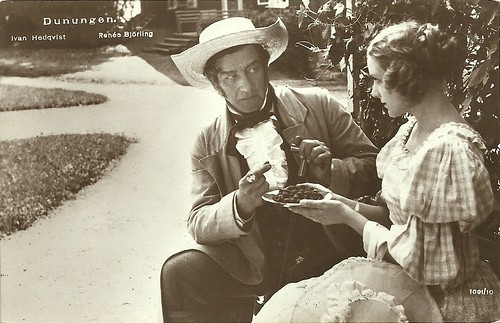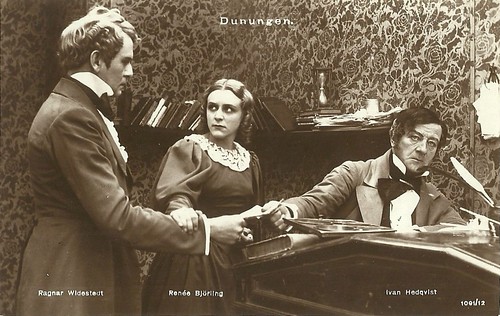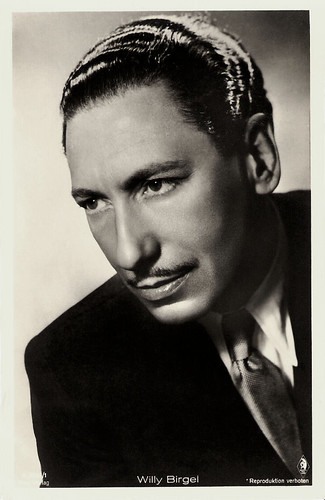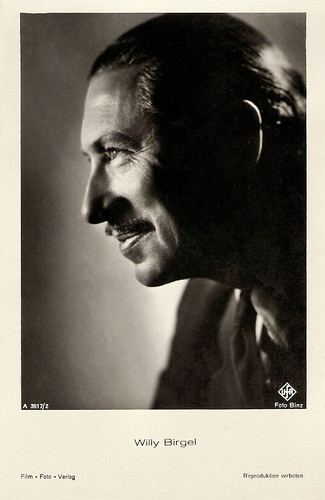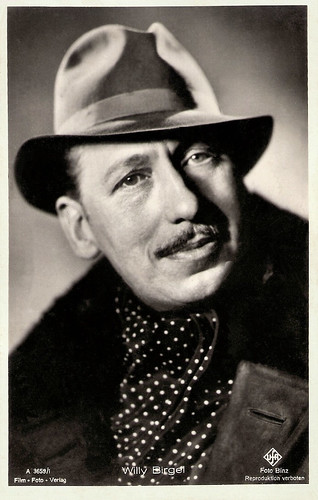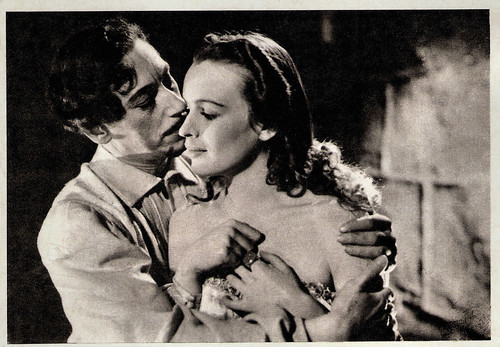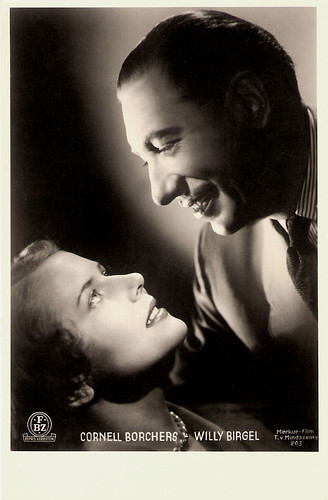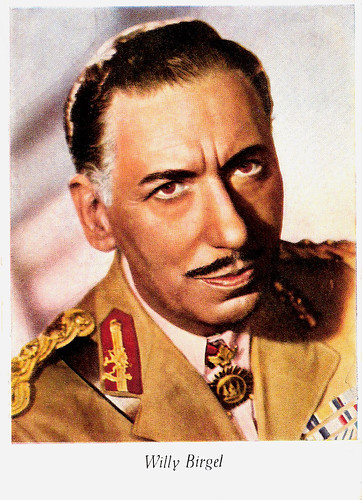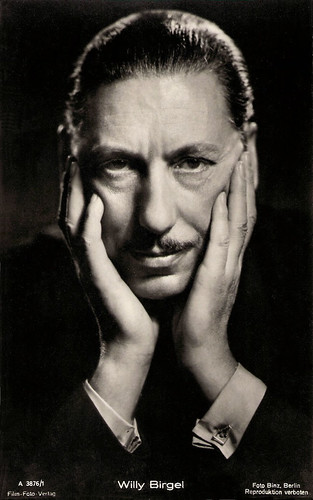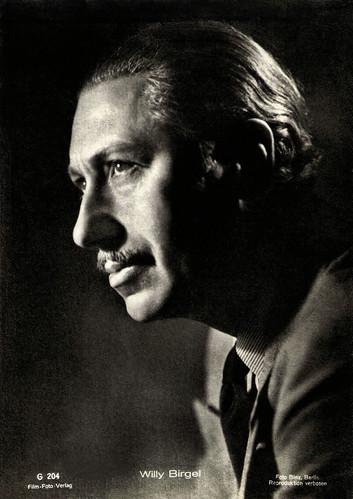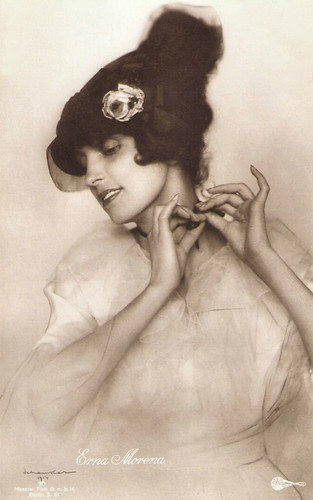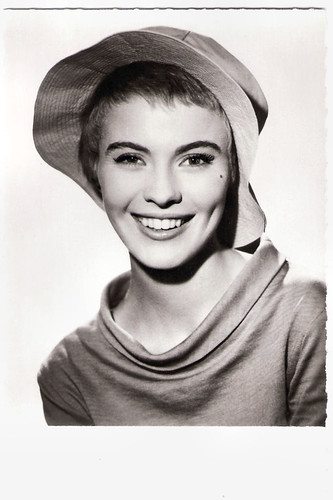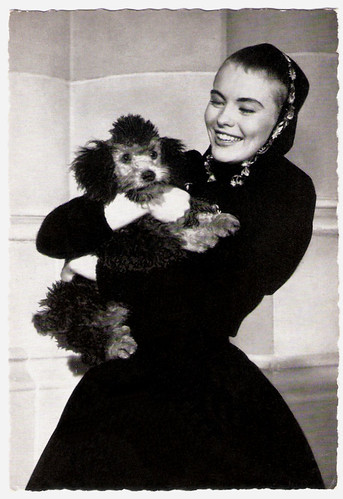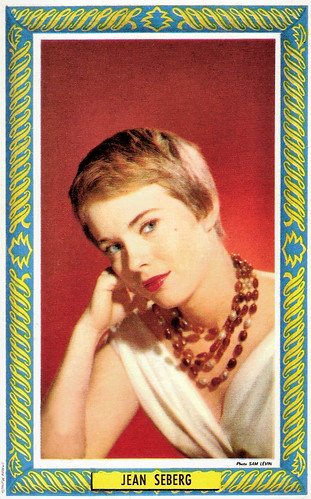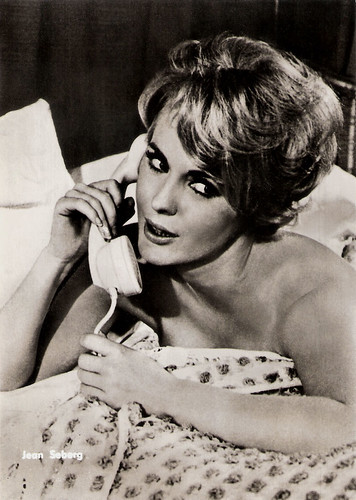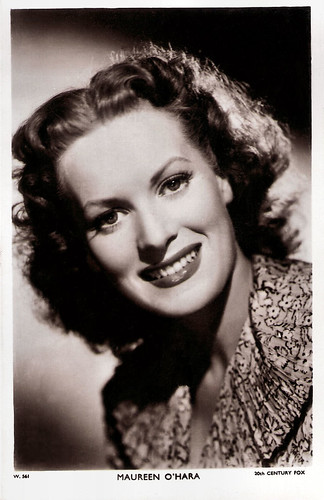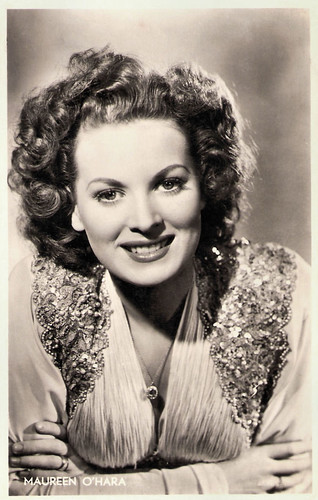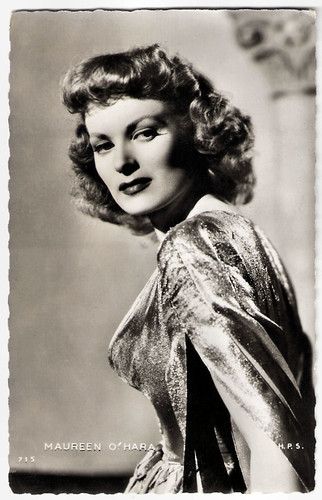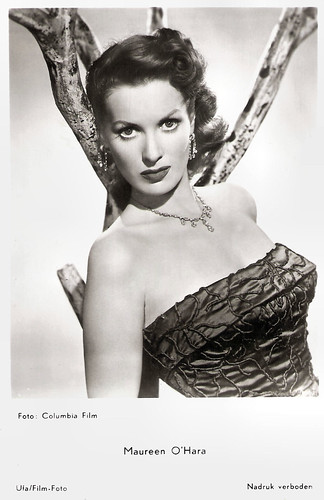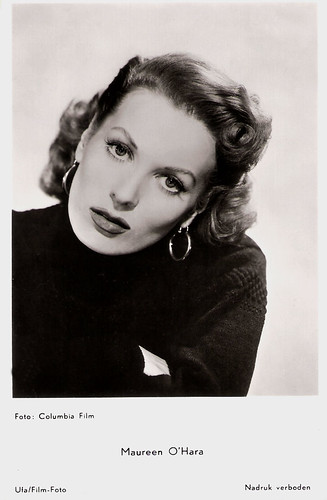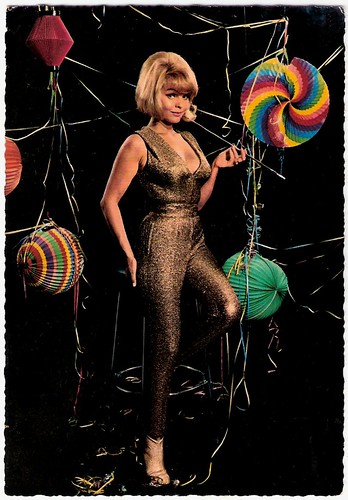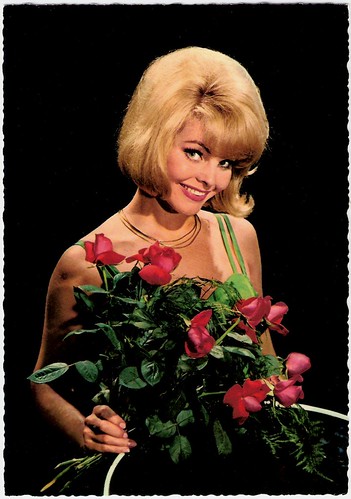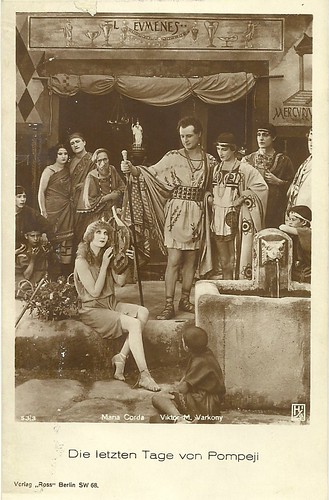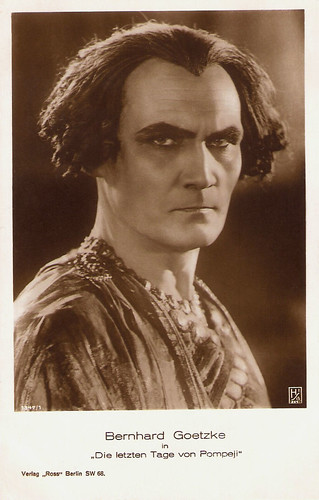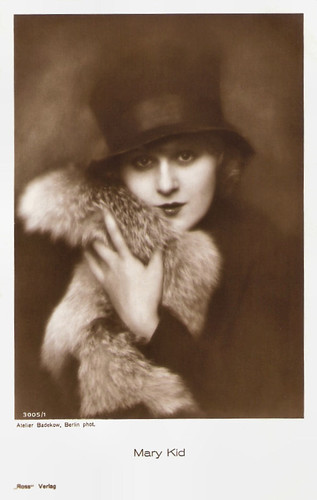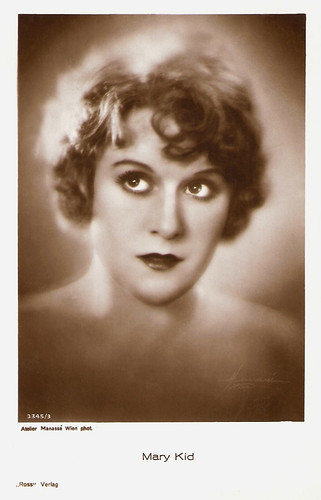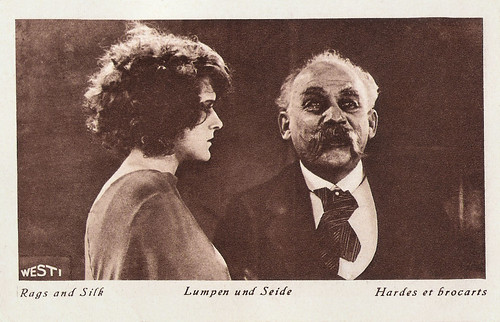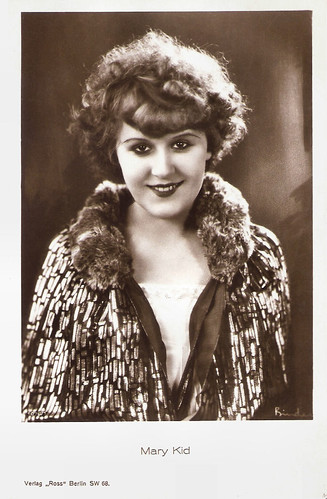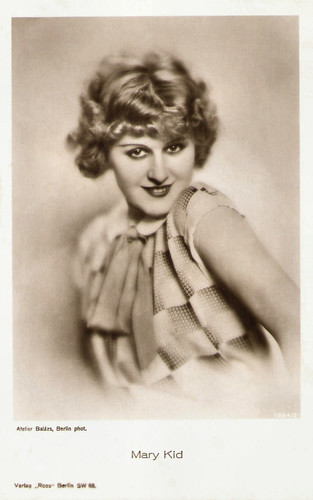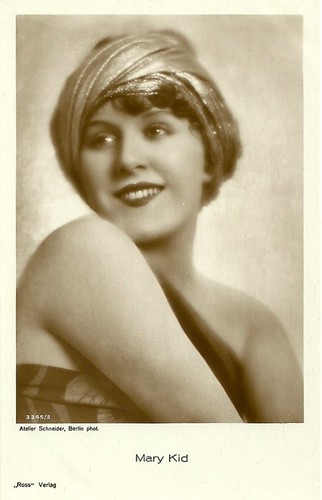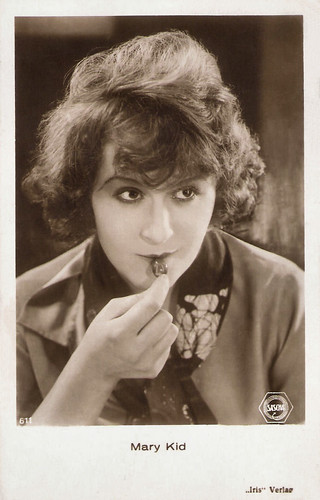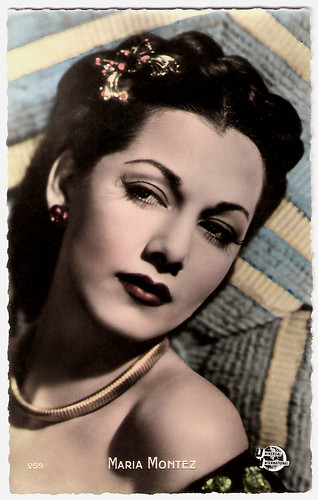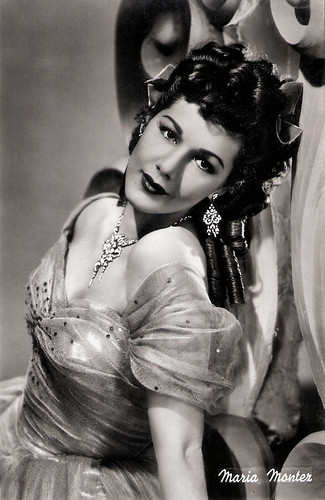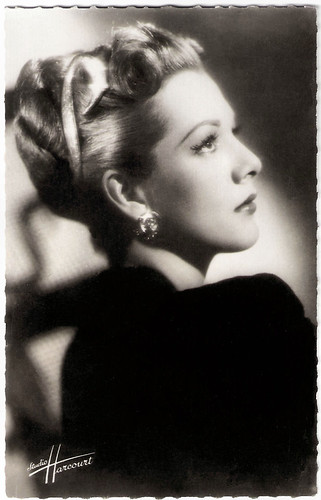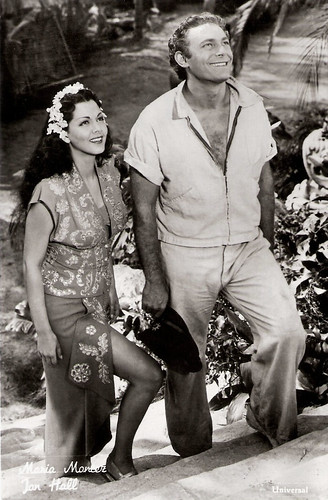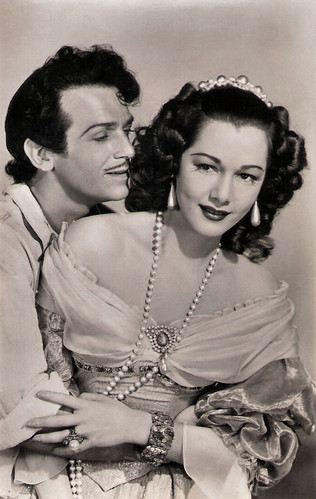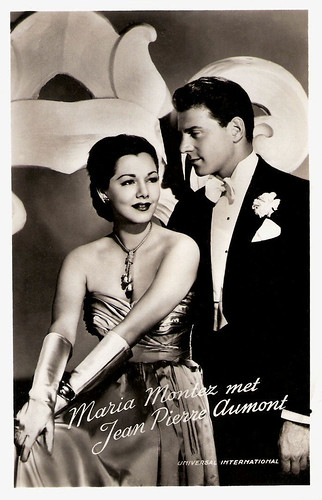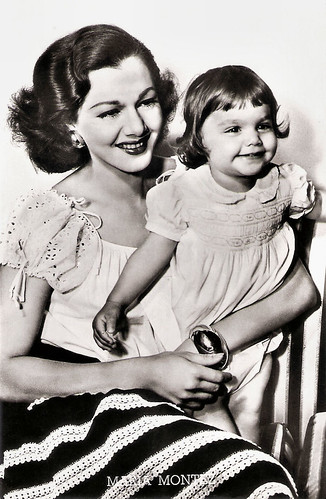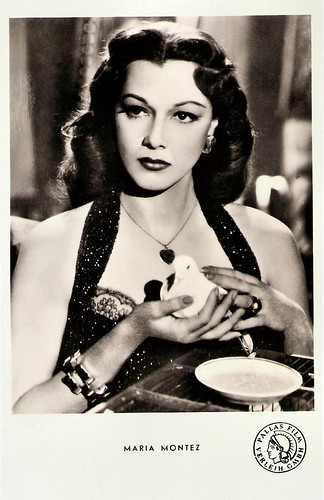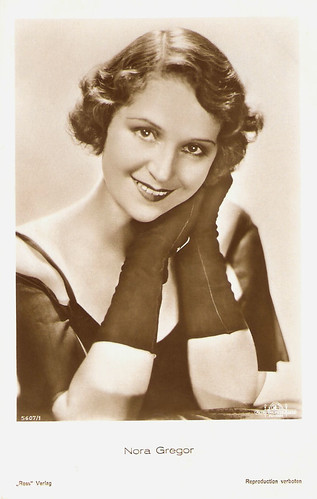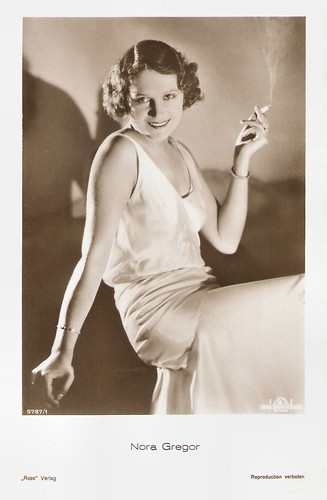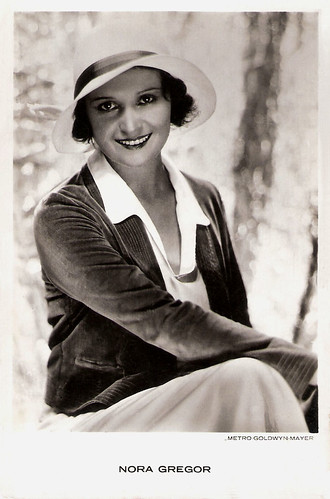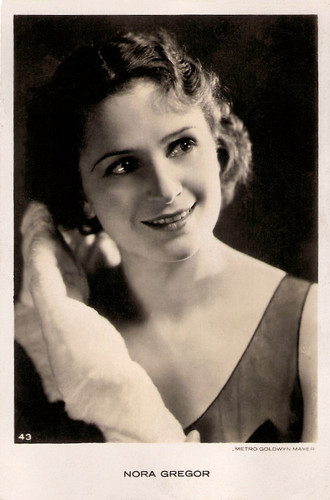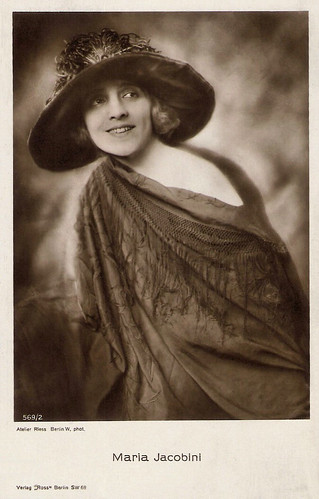The Italian-German silent film Gli ultimi giorni di Pompei/The Last Days of Pompeii (Amleto Palermi, Carmine Gallone, 1926) was one of the many adaptations of the novel The Last Days of Pompeii (1834) by Edward George Bulwer-Lytton. The stars were the Hungarian actors Victor Varconi and Maria Corda, the Italian actress Rina De Liguoro and the German Bernhard Goetzke. Original release prints of the film were entirely colourised by the Pathechrome stencil colour process.![Gli ultimi giorni di Pompei]()
Italian postcard by C. Chierichetti, Milano. Photo: Grandi Films, Roma. Publicity still for
Gli ultimi giorni di Pompei/The Last Days of Pompeii (Amleto Palermi, Carmine Gallone, 1926).
Glaucus (
Victor Varconi) training at the gymnasium.
![Gli ultimi giorni di Pompei]()
Italian postcard by C. Chierichetti, Milano. Photo: Grandi Films, Roma. Publicity still for
Gli ultimi giorni di Pompei/The Last Days of Pompeii (Amleto Palermi, Carmine Gallone, 1926).
Pompeian street life with the rich Greek Glaucus (
Victor Varconi) and his wealthy friends meeting the blind flower girl Nydia (
Maria Corda), who also sings and plays the lyre. The bearded man left in the back is Burbo (Carlo Duse), the brutal tavern owner, who owns Nydia as a slave.
![Gli ultimi giorni di Pompei]()
Italian postcard by C. Chierichetti, Milano. Photo: Grandi Films, Roma. Publicity still for
Gli ultimi giorni di Pompei/The Last Days of Pompeii (Amleto Palermi, Carmine Gallone, 1926).
A Pompeiian street with Burbo's tavern. Sets were by
Vittorio Cafiero, costumes by
Duilio Cambellotti.
![Gli ultimi giorni di Pompei]()
Italian postcard by C. Chierichetti, Milano. Photo: Grandi Films, Roma. Publicity still for
Gli ultimi giorni di Pompei/The Last Days of Pompeii (Amleto Palermi, Carmine Gallone, 1926).
Glaucus (
Victor Varconi) has saved Nydia (
Maria Corda) from Burbo and taken into his house. Nydia loves Glaucus, but he can only think of Ione.
![Gli ultimi giorni di Pompei]()
Italian postcard by C. Chierichetti, Milano. Photo: Grandi Films, Roma. Publicity still for
Gli ultimi giorni di Pompei/The Last Days of Pompeii (Amleto Palermi, Carmine Gallone, 1926).
Nydia, in love with Glaucus, thinks she has given Glaucus a love potion, but instead it makes him delirious. It is Arbaces who has concocted this.
The Novel and the painting
The novel
The Last Days of Pompeii was written by the baron
Edward Bulwer-Lytton in 1834. The novel was inspired by the painting
The Last Day of Pompeii by the Russian painter
Karl Briullov, which Bulwer-Lytton had seen in Milan.
The novel culminates in the cataclysmic destruction of the city of Pompeii by the eruption of Mount Vesuvius in AD 79. The novel became a bestseller, helped on its release by the eruption of Vesuvius just before publication.
The Last Days of Pompeii uses its characters to contrast the decadent culture of 1st-century Rome with both older cultures and coming trends. The protagonist, Glaucus, a handsome Athenian nobleman and Ione's betrothed, represents the Greeks who have been subordinated by Rome.
His nemesis is Arbaces, a scheming Egyptian sorcerer and a high priest of Isis, and the former guardian of Ione and her brother Apaecides. Arbaces represents the still older culture of Egypt. He murders Apaecides and frames Glaucus for the crime. Repeatedly he attempts to seduce Ione.
Olinthus is the chief representative of the nascent Christian religion, which is presented favourably but not uncritically. The Christian converts Apaecides to Christianity and is sentenced to death for his religion.
![Maria Corda and Victor Varconi in The Last Days of Pompeii (1926)]()
German postcard by Ross Verlag, no. 53/3. Photo: Hisa Film-Vertrieb. Publicity still for
Gli ultimi giorni di Pompei/The Last Days of Pompeii (Carmine Gallone, Amleto Palermi, 1926). Collection: Didier Hanson.
![Victor Varconi as Glaucus in Gli ultimi giorni di Pompei (1926)]()
German postcard by Ross Verlag, no. 1344/2, 1927-1928. Photo: Hisa Film-Vertrieb. Publicity still for
Gli ultimi giorni di Pompei/The Last Days of Pompeii (Carmine Gallone, Amleto Palermi, 1926).
Victor Varconi as Glaucus.
![Bernhard Goetzke in Gli ultimi giorni di Pompei]()
German postcard by Ross Verlag, no. 1347/1, 1927-1928. Photo: Hisa Film-Vertrieb. Publicity still for
Gli ultimi giorni di Pompei/The Last Days of Pompeii (Carmine Gallone, Amleto Palermi, 1926).
Bernhard Goetzke as the evil Egyptian priest Arbaces.
![Gli ultimi giorni di Pompei]()
Italian postcard by C. Chierichetti, Milano. Photo: Grandi Films, Roma. Publicity still for
Gli ultimi giorni di Pompei/The Last Days of Pompeii (Amleto Palermi, Carmine Gallone, 1926).
The funeral of Apecides (
Vittorio Evangelisti). Apecides, brother of Glaucus' lover Ione and former pupil of the Egyptian high priest of Isis, Arbaces, has converted to Christianity and threatens to unmask Arbaces's frauds. Arbaces stabs him and puts the blame on Glaucus, drugged unknowingly by Nydia. The priest in the middle is Calenus (
Emilio Ghione), who has seen Arbaces murdering Apecides. Arbaces himself (
Bernhard Goetzke) can be seen extreme left.
![Gli ultimi giorni di Pompei]()
Italian postcard by C. Chierichetti, Milano. Photo: Grandi Films, Roma. Publicity still for
Gli ultimi giorni di Pompei/The Last Days of Pompeii (Amleto Palermi, Carmine Gallone, 1926).
At the Via delle Tombe in Pompeii the funeral service for the murdered Apecides is held. In the centre is the priest Calenus (
Emilio Ghione).
The Star Cast
Handsome
Victor Varconi (1891–1976) was as Glaucus the male star of
Gli ultimi giorni di Pompei/The Last Days of Pompeii. The Hungarian Varconi, originally Viktor Varkony, was a highly successful matinee idol of the Hungarian-Austrian and German silent cinema in the 1910s and early 1920s. Later he was the first Hungarian actor to become a Hollywood star until the sound film completely altered the course of his career.
Hungarian
Maria Corda (1898-1975) played the slave girl Nydia, who is in love with Glaucus. Corda was an immensely popular star of the silent cinema of Austria and Germany. The pretty, blonde actress was a queen of the popular epic spectacles of the 1920s, which were often directed by her husband,
Alexander Korda.
Not pictured on one of the postcards is
Rina De Liguoro (1892-1966) as Ione. She was the last diva of the Italian silent cinema of the 1920s. De Liguoro had her breakthrough in 1924 as the sensual, untamed Roman empress Messalina, and the beautiful countess continued her glittering career in such epics as
Quo Vadis (1924),
Casanova (1927) and
Cecil B. De Mille's notorious box office flop
Madam Satan (1930).
Emilio Ghione (1879-1930), who played Calenus, was an Italian silent film actor, director and screenwriter. He is best known for writing, directing and starring in the Za La Mort series of adventure films, in which he played a likeable French apache and 'honest outlaw.'
The evil Egyptian priest Arbaces was played by German film actor
Bernhard Goetzke (1884–1964). He was one of the impressive stars of German silent cinema, in particular in the films by Fritz Lang. Goetzke appeared in 130 films between 1917 and 1961.
![Gli ultimi giorni di Pompei]()
Italian postcard by C. Chierichetti, Milano. Photo: Grandi Films, Roma. Publicity still for
Gli ultimi giorni di Pompei/The Last Days of Pompeii (Amleto Palermi, Carmine Gallone, 1926).
Calenus (
Emilio Ghione) tries to blackmail Arbaces (
Bernhard Goetzke). Arbaces leads him to his treasury.
![Gli ultimi giorni di Pompei]()
Italian postcard by C. Chierichetti, Milano. Photo: Grandi Films, Roma. Publicity still for
Gli ultimi giorni di Pompei/The Last Days of Pompeii (Amleto Palermi, Carmine Gallone, 1926).
Calenus (
Emilio Ghione) has been fooled by Arbaces and is locked up in the treasury, which is also a dungeon.
![Gli ultimi giorni di Pompei]()
Italian postcard by C. Chierichetti, Milano. Photo: Grandi Films, Roma. Publicity still for
Gli ultimi giorni di Pompei/The Last Days of Pompeii (Amleto Palermi, Carmine Gallone, 1926).
At the basilica (courts of justice). Glaucus (
Victor Varconi) is sentenced to die.
![Gli ultimi giorni di Pompei]()
Italian postcard by C. Chierichetti, Milano. Photo: Grandi Films, Roma. Publicity still for
Gli ultimi giorni di Pompei/The Last Days of Pompeii (Amleto Palermi, Carmine Gallone, 1926).
Glaucus (
Victor Varconi) and the Christian Olintus (
Ferruccio Biancini), the man on the right, in the prison of the Christians, waiting for their ordeal in the arena.
The adaptations
The first theatrical adaptation of The Last Days of Pompeii was
Errico Petrella's opera
Jone, with a libretto by
Giovanni Peruzzini. It premiered at La Scala in 1858. It was very successful and remained in the Italian repertoire well into the 20th century. In 1877 followed an ambitious theatrical adaptation, which was mounted at the Queen's Theatre, Long Acre in London. It featured a staged eruption of the Vesuvius, an earthquake and a sybaritic Roman feast – the earth did not quake, the volcano did not work, acrobats fell onto the cast below, and the production was an expensive flop.
The first film version was the British short film
The Last Days of Pompeii (1900), directed by
Walter R. Booth. Eight years later followed
Gli ultimi giorni di Pompei/The Last Days of Pompeii (Arturo Ambrosio, Luigi Maggi, 1908). In 1913 followed to more Italian silent film versions,
Gli ultimi giorni di Pompei/The Last Days of Pompeii (Mario Caserini, 1913), and
Jone ovvero gli ultimi giorni di Pompei/Jone or the Last Days of Pompeii (Giovanni Enrico Vidali, Ubaldo Maria Del Colle, 1913).
The first sound version was the Hollywood production
The Last Days of Pompeii (Ernest B. Schoedsack, Merian C. Cooper, 1935), with
Preston Foster and
Basil Rathbone. It carried a disclaimer that, although the movie used the novel's description of Pompei, it did not use its plot or characters. The film was a moderate success on its initial release, but made an overall loss of $237,000.
After the war followed the French-Italian version
Gli ultimi giorni di Pompei/Les Derniers Jours de Pompéi/The Last Days of Pompeii (Marcel L'Herbier, Paolo Moffa, 1950), starring
Micheline Presle and
Georges Marchal. The amphitheatre scenes were filmed at the Arena di Verona. The next adaptation was another Italian version,
Gli ultimi giorni di Pompei/The Last Days of Pompeii (Sergio Leone, 1959), starring
Steve Reeves.
Mario Bonnard, the original director, fell ill on the first day of shooting, so assistant director Leone and the scriptwriters finished the film. Later followed two TV versions and a German stage musical,
Pompeji (2008).
But how was the 1926 version?
David Melville reviews at
IMDb: "The last of the great silent Italian epics, The Last Days of Pompeii is as lavish as anything produced by Hollywood at that time - only much, much raunchier. During an orgy in the house of the evil priest Arbaces, naked slave girls are served up (literally!) on platters decked with flowers. A nubile mummy rises out of her sarcophagus to do a striptease and bare-breasted sphinx statues come to life as her chorus line. In the gladiators' tavern, wildly effeminate men (kohl-dark eyelids and lipstick as thick as clotted blood) drool and bat their eyes over so much naked, muscular flesh. All in all, the most satisfyingly decadent Ancient Rome saga until
Fellini Satyricon in 1968!"
![Gli ultimi giorni di Pompei]()
Italian postcard by C. Chierichetti, Milano. Photo: Grandi Films, Roma. Publicity still for
Gli ultimi giorni di Pompei/The Last Days of Pompeii (Amleto Palermi, Carmine Gallone, 1926).
Glaucus (
Victor Varconi) in prison. The man on the right is the Christian Olintus (
Ferruccio Biancini), who had converted Apecides. Olintus will see the eruption and destruction of Pompeii as a punishment of God.
![Gli ultimi giorni di Pompei]()
Italian postcard by C. Chierichetti, Milano. Photo: Grandi Films, Roma. Publicity still for
Gli ultimi giorni di Pompei/The Last Days of Pompeii (Amleto Palermi, Carmine Gallone, 1926).
Glaucus is sentenced to die in the arena, eaten by lions, when just in time Glaucus's friend Sallustius, Nydia, Ione and Calenus expose Arbaces as the real murderer and he threatens to be lynched by the mob. Suddenly the Vesuvius erupts and the terrorised people flee.
![Gli ultimi giorni di Pompei]()
Italian postcard by C. Chierichetti, Milano. Photo: Grandi Films, Roma. Publicity still for
Gli ultimi giorni di Pompei/The Last Days of Pompeii (Amleto Palermi, Carmine Gallone, 1926).
The destruction of the house of Glaucus.
Sources:
David Melville (IMDb),
Wikipedia and
IMDb.
![Rina De Liguoro in Bufera]()
![Rina De Liguoro in Bufera]()
![Rina De Liguoro in Bufera]()
![Rina De Liguoro and Celio Bucchi in Bufera]()
![Rina De Liguoro in Bufera]()
![Rina de Liguoro]()



